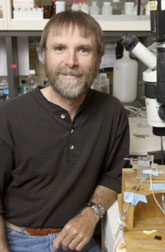Faculty A-Z

John Smeda
Professor of Cardiovascular/Renal Physiology B.Sc.(Hons.), M.Sc. Brock, Ph.D. McMasterBioMedical Sciences
Alterations in Cerebrovascular Function Associated with Stroke
Hemorrhagic stroke occurs when a blood vessel(s) within the brain bursts. This form of stroke is particularly lethal (70% mortality in humans within two weeks) and produces a high degree of disability in stroke survivors.
Studies within our lab have indicated that hemorrhagic stroke development in an animal model of hemorrhagic stroke (called the Kyoto Wistar stroke prone hypertensive rat (SHRsp)) has similar properties to that present in humans. We have found that when SHRsp are given captopril up to 6 days after stroke development, the treatment extends the animal’s life span from 1.5 weeks to greater than 23 weeks. Captopril lowers blood angiotensin II (AII) and aldosterone levels. If blood aldosterone is raised in SHRsp during captopril treatment (via infusion through an osmotic pump) to levels that would be present in SHRsp just after stroke development, the beneficial effects of captopril are negated suggesting that the suppression of aldosterone is particularly important in promoting the effects of captopril.
We believe continued poststroke captopril treatment restores normal cerebrovascular function which prevents the development of new cerebral hemorrhages. We have studied the brain arteries of SHRsp. The loss of cerebral blood flow regulation is associated with an inability of the arteries to sense blood pressure and appropriately constrict to pressure to maintain flow at normal levels. We know from preliminary studies that captopril treatment after stroke restores cerebral blood flow regulation, pressure dependent constriction in isolated cerebral vessels and repairs the PKC system and that plasma aldosterone modulation plays an important role in this process.
In our view a change in the neuro-hormonal physiological milieu not only contributes to the initiation of spontaneous intracerebral hemorrhage but also promotes death after hemorrhage has formed.
Publications
Smeda, J.S., Stroke development in stroke-prone spontaneously hypertensive rats alters the ability of cerebrovascular muscle to utilize internal Ca2+ to elicit constriction. Stroke. 2003 34(6): 1491-1496.
Smeda, J,S., Alterations in autoregulatory and myogenic function in the cerebrovasculature of Dahl salt-sensitive rats. Stroke. 2003 34(6): 1484-1490.
Payne G,W, Smeda JS., Cerebrovascular alterations in pressure and protein kinase C-mediated constriction in Dahl Salt-sensitive rats. J Hypertens. 2002 20(7): 1355-1363.
Smeda, J.S., King, S. Electromechanical alterations in the cerebrovasculature of stroke-prone rats. Stroke 2000. 31(3): 751-8.
Smeda, J.S., Van Vliet, B.N., King, S.R. Stroke-prone spontaneously hypertensive rats lose their ability to auto-regulate cerebral blood flow prior to stroke. J Hypertens. 1999 17: 1697-705.
Smeda, J., Vasdev, S., King, S.R. Effect of poststroke captopril treatment on mortality associated with hemorrhagic stroke in stroke-prone rats. J Pharmacol Exp Ther. 1999 291(2): 569-75.
Smeda, J.S., King, S. Cerebrovascular alterations in protein kinase C-mediated constriction in stroke-prone rats. Stroke. 1999 30(3): 656-61.